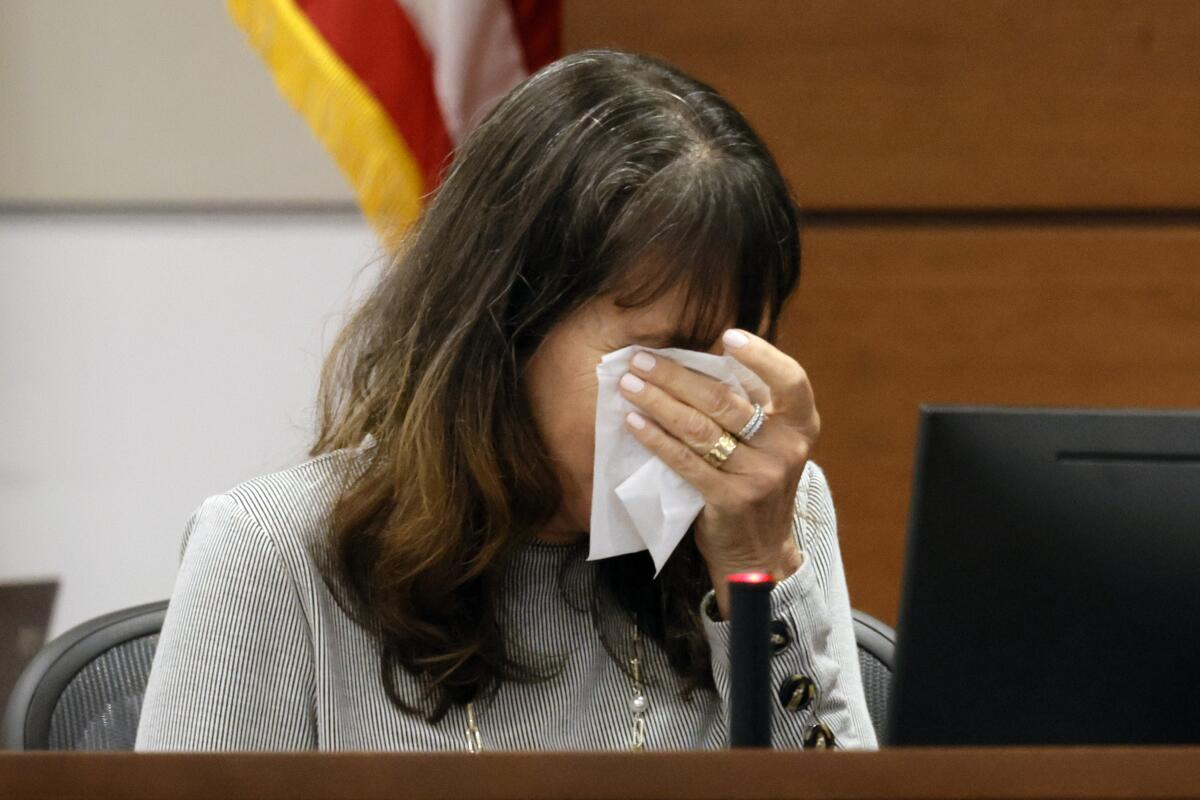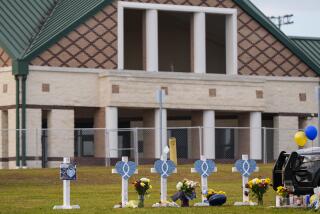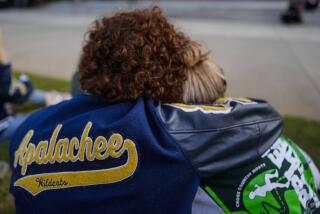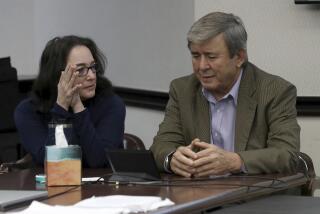Teachers weep recalling students killed in Parkland shooting

- Share via
FORT LAUDERDALE, Fla. — Teachers gave heart-wrenching testimony Wednesday in the penalty trial of Nikolas Cruz, with one recalling that a boy in her Holocaust studies class correctly answered a question seconds before he became one of 17 people murdered during the shooter’s rampage four years ago.
Ivy Schamis, then a teacher at Marjory Stoneman Douglas High School in Parkland, Fla., was leading students through a discussion about the 1936 Olympics in Nazi Germany when star swimmer Nick Dworet correctly responded that Adolf Dassler founded the Adidas shoe company. He then added that Dassler’s brother founded the rival Puma brand.
It was then that they heard the initial gunshots in the first-floor hallway of the three-story building, and Cruz began firing his semiautomatic rifle through the glass on her classroom door near where he entered.
“It was really seconds later that the barrel of that AR-15 just ambushed our classroom,” Schamis testified, wiping her eyes with a tissue. “It came right through that glass panel and was just shooting everywhere. It was very loud. Very frightening. I kept thinking about these kids who should not be experiencing this at all.”
She said the students scrambled to find safety behind furniture but didn’t panic and acted with bravery and maturity as they waited to be rescued. Three students were wounded in her class and two were killed: Dworet and Helena Ramsay, both 17.
When shown their portraits, she began to weep.
“That’s my girl, Helena Ramsay,” she said. “Nicholas Dworet, handsome boy.”
Dworet’s brother Alexander was grazed by a bullet in a classroom across the hall, where three students were killed and several more wounded.
Cruz, 23, pleaded guilty in October to 17 counts of first-degree murder for the Feb. 14, 2018, massacre. The jury must decide whether the former Stoneman Douglas student should be sentenced to death or life without parole for the nation’s deadliest mass shooting to go before a jury. The trial is expected to last through at least October.
Nine other gunmen who killed at least 17 people died during or immediately after their shootings, either by suicide or police gunfire. The suspect in the 2019 slaying of 23 people at a Walmart in El Paso is awaiting trial.
Schamis’ testimony was followed by that of Ronit Reoven, who was lecturing in her advanced psychology class about Sigmund Freud when Cruz started firing into her neighboring classroom, also through the door’s window.
“There were multiple gunshots,” she said. “They were incredibly loud. Boom boom boom boom boom! I froze for a moment, and the students jumped out of their seats. Of course, they were startled and scared.”
Reoven said that she and the students crouched on the floor around her desk and that wounded students were moaning and crying. She used a blanket that normally covered her coffee machine as a tourniquet to stop the bleeding from a boy’s arm. Another boy used a jacket to stanch the bleeding from a girl’s chest. A girl shot in the knee appeared to be stable. But 16-year-old Carmen Schentrup was lying facedown in a pool of blood.
“I knew that she was probably gone,” Reoven said.
On the third floor, Stacey Lippel was teaching creative writing and Ernest Rospierski was supervising study hall when Cruz’s shots on the first floor triggered the fire alarm. Not realizing a shooting was happening below them, they led their students into the hallway to evacuate.
That’s when screaming students began coming back up the stairwell and they could hear gunshots.
Lippel said she and the teacher from the neighboring room, Scott Beigel, quickly reopened their doors and started getting students back inside. It was then that Cruz emerged from the stairwell, “splaying the rifle back and forth, shot after shot after shot,” she said. “It never stopped.”
Lippel said she got inside her room and closed the door, but Beigel was fatally shot.
Beigel’s student Veronica Steel testified that his body kept the door from closing, leaving the students in the room fearful Cruz would come inside.
“It was scary. We didn’t know what to do,” she said.
Rospierski’s head and hip were grazed by bullets, but he helped students flee down a stairwell after Cruz passed.
The testimony came a day after jurors saw surveillance video showing victims being gunned down at point-blank range. Cruz also killed some of the wounded by firing on them a second time as they lay on the floor.
When jurors eventually get the case, they will vote 17 times, once for each of the victims, on whether to recommend capital punishment.
For each death sentence, the jury must be unanimous or the sentence for that victim is life. The jurors are told that to vote for death, the prosecution’s aggravating circumstances for that victim must, in their judgment, outweigh the defense’s mitigators. A juror can also vote for life out of mercy for Cruz. During jury selection, the panelists said under oath that they are capable of voting for either sentence.
Associated Press reporter Freida Frisaro in Miami contributed to this report.
More to Read
Sign up for Essential California
The most important California stories and recommendations in your inbox every morning.
You may occasionally receive promotional content from the Los Angeles Times.










